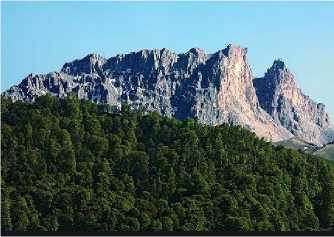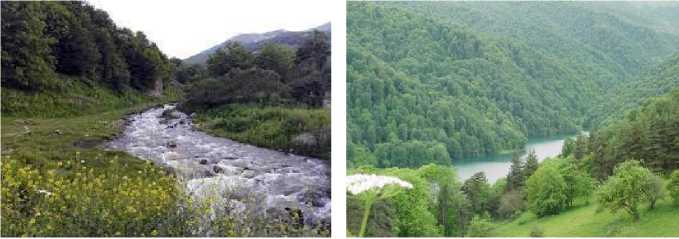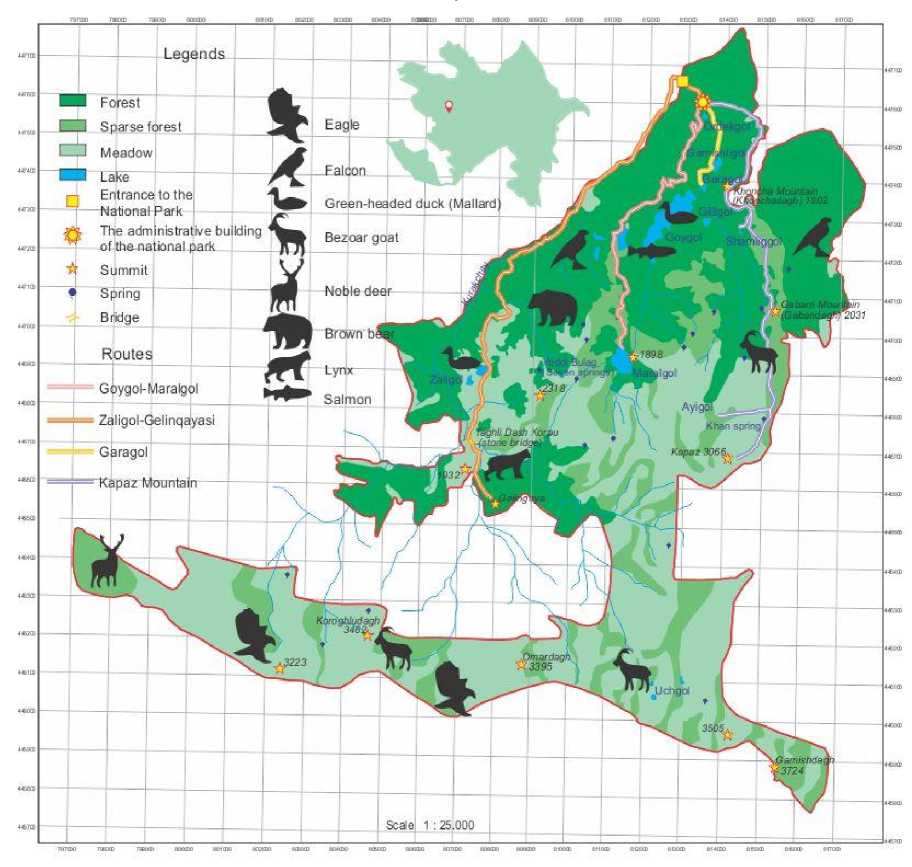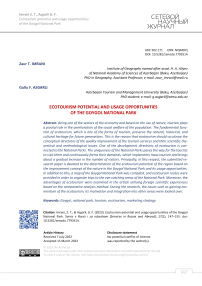Ecotourism potential and usage opportunities of the Goygol national park
Автор: Zaur T. Imrani, Gullu F. Asgarli
Журнал: Сервис в России и за рубежом @service-rusjournal
Рубрика: Маркетинг услуг и территорий
Статья в выпуске: 1 (103), 2023 года.
Бесплатный доступ
Being one of the sectors of the economy and based on the use of nature, tourism plays a pivotal role in the amelioration of the social welfare of the population. The fundamental function of ecotourism, which is one of the forms of tourism, preserve the natural, historical, and cultural heritage for future generations. This is the reason that ecotourism should scrutinise the conceptual directions of the quality improvement of the tourism services and their scientific-theoretical and methodological issues. One of the development directions of ecotourism is connected to the National Parks. The uniqueness of the National Parks paves the way for the tourists to visit them and continuously forms their demands, which implements mass tourism and brings about a gradual increase in the number of visitors. Principally, in this respect, the submitted research paper is devoted to the determination of the ecotourism potential of the region based on the improvement concept of the nature in the Goygol National Park and its usage opportunities. In addition to this, a map of the Goygol National Park was compiled, and ecotourism routes were provided in order to organize trips to the eye-catching areas of the National Park. Moreover, the advantages of ecotourism were examined in the article utilising foreign scientific experiences based on the comparative analysis method. During the research, the issues such as gaining momentum of the ecotourism, its motivation and integration into other areas were looked over.
Goygol, national park, tourism, ecotourism, marketing strategy
Короткий адрес: https://sciup.org/140297100
IDR: 140297100 | УДК: 502.171 | DOI: 10.5281/zenodo.7793514
Текст научной статьи Ecotourism potential and usage opportunities of the Goygol national park
To view a copy of this license, visit
In the modern world, the resort and destination centers are improving in the ecological (environmental) aspects. Intriguingly, the reservation of the natural complexes is becoming more and more inviolable areas of economic activity. Simply because, in recent years, the phenomenon of ecotourism, which in recent years has become a paradigm of the tourism sector, is conceptually understood. For several countries, ecotourism is the backbone of the national economy. This not only stimulates the development of tourism, allows it to integrate into other areas, but also increases the role of nature functions based on many scientific and theoretical knowledge, helps to understand nature and raises awareness among the community. However, it should be borne in mind that ecotourism is not only accepted a trip to exotic natural areas, their fauna and flora for educational and spiritual purposes, but also a set of interconnected complexes to solve environmental problems through the implementation of local socio-economic issues. Because ecotourism is a purposeful trip to natural areas to gain a deeper understanding of ecological culture through the protection of natural resources and the environment, taking into account the interests of local people.
Ecotourism is factored in a type of tourism, nonetheless, it is traditionally classified as a travel tour. This classification serves as the primary motivation for the trip [12]. According to the longterm investigations implemented by us, we may enunciate that ecotourism differentiates as its five components and these include a purely natural environment, environmental sustainability, awareness, income and benefits for the local people, and tourist satisfaction.
The development of ecotourism in Azerbaijan is carried out in national parks with specially protected natural areas. However, a number of serious environmental problems can occur during planned ecotourism trips in national parks. For example, vehicles used to transport tourists to the destination, tents set up in forests and near water bodies, picnics and recreation areas, etc. can cause pollution of the surrounding areas. In this regard, ecological tours urge tourists to understand the problems and take an active part in solving them.
A concept of ecotourism
The history of the relationship between society and nature is complex and controversial. Because mankind cannot exist without using natural resources. "Human-Environment" (or "HumanNature") alters the balance of global processes and is constantly in dynamic contact with each other. If there is a change in one of them, the same change is observed in the second. This is a direct reference to an environmental scientific paradigm based on the provisions of the school of geography [18]. Such a situation has created a need for the effective and sustainable development of ecotourism, which is the basis of all segments of tourism activities [6].
One of the first concepts of ecotourism was put forward in 1965 by D. Hetzer. D. Hetzer called ecotourism an activity based on natural and archaeological resources, nature travel, scenic areas, rocks, caves, archaeological sites, swamps, places of distribution of rare or endangered species of flora and fauna as ecotourism centres [3]. However, in 1983, H. Seballos-Lascurain elaborated widely on the concept of ecotourism in the understanding of the ecocentric value system based on the rational use of natural resources in the science community and proposed to abandon communications, access to several tourist goods and consumer value in ecotourism activities [14]. K. Lindberg and D. Hawking suggest using a common conceptual definition, calling ecotourism a sustainable and nature-oriented type of tourism and recreation [13]. On the contrary, I. V. Zorin and V. A. Kvartalnov denominate the concept of ecotourism a direct trip to nature using environmentally friendly technologies. According to them, state-of-the-art ecotourism products do not have a negative impact on nature during such trips and strengthen nature conservation awareness [17].
In the world practice, the concept of ecotourism was clarified on November 22, 2019, in the Law "On Ecological Tourism". The law defines ecotourism as a journey that creates an image of areas with natural, cultural and ethnographic features, does not violate the integrity of ecosystems and contributes to the well-being of the local pop-ulation1. As a consequence of the abovementioned notions, it is evident that ecotourism is a trip to untouched areas to contribute to the protection of nature, have a "soft" impact on the environment, and ensure the socio-economic participation of local people, and enjoy natural components.
Summarizing the concept of ecotourism, we can enunciate that it is the certain tours organized on the principle of compliance with cultural norms of tourist behaviour in the environment, along with the traditional criteria for achieving sustainability – the motivation of travel and the flow of tourists. The tours involve the application of methodological components considered as nature conservation activities (including awarenessraising activities), conceptual approaches that meet environmental requirements, and organizational forms of tourism [1]. This is feasible through the sustainability of the ecological environment, the preservation of natural and ethnocultural resources, the promotion of national traditions and folk crafts, and the organization of ecotourism routes.
One of the scientific and theoretical problems of ecotourism is that the concept of ecotourism is broad and indefinite. Thus, there are various approaches to ecotourism in the scientific literature, and this methodological problem has not yet been resolved.
Goygol National Park
In today’s world, the development and application of various models are required for the protection of attractive natural areas, the conservation of endangered flora and fauna, as well as the sustainable development of national socioeconomic systems. It is a known fact that there are different forms and directions of activity in protected natural areas, which is due to their national characteristics. National parks are one of the protected natural areas and have socio-economic advantages from the regional point of view.
National parks are a special form of active recreation in natural areas created and protected for the preservation of natural monuments, and historical and cultural heritage sites. National parks cover relatively large areas, where: 1) the ecosystem remains unchanged, plant species and wildlife are of scientific, educational and recreational interest; 2) the rules for preventing the economic exploitation of natural resources in the territory shall be observed by state bodies; 3) Visitors visit the area to meet their educational and cultural recreation needs [11]. National parks are also considered to be tourist destinations, cleaned hunting grounds and other areas. Special areas (zones) are created here for the organization of services (accommodation, meals, parking, sports grounds, etc.) and public recreation areas [15].
National parks are created by the government as specially protected areas and attract tourists to the unique spatial facilities in these areas. In world practice, the management of national parks demonstrates the positive impact of local communities on the principle of operation and sustainable development of this system. Since the national parks have played an important role in creating business opportunities for the self-employed and small businesses.
Generally speaking, national parks, along with the functions of protection of natural complexes, environmental education, scientific research and environmental monitoring, create convenient conditions for the protection and restoration of historical and cultural heritage, as well as the organization of regulated tourism and recreation. National parks form the basis of the policy of strategic management of specially protected natural areas. Their primary responsibilities include:
-
- protection and restoration of natural complexes;
-
- protection and restoration of historical and cultural heritage sites;
-
- organization of nature protection and ecological education;
-
- sustainable development of tourism, especially ecotourism;
-
- conducting scientific research;
-
- implementing regular environmental monitoring.
As the network of national parks expands around the world, recreational and information eco-centers are being established that provide visitors with the best examples of natural, historical and cultural heritage. Ecotourism is being developed in recreational and educational tourism zones for sightseeing. National parks eliminate the contradictions between recreation and nature protection, create conditions for effective recreation services, as well as the formation of civic attitudes to natural, historical and cultural heritage [16]. One of such national parks in the Republic of Azerbaijan is Goygol National Park.
Goygol National Park was established on April 1, 2008, in the territory of the Goygol, Dash-kasan and Goranboy administrative districts for the purpose of protection of rare plant species and endangered species and animals, protection of the environment, as well as developing of eco-tourism2. The national park is located in the northeast of the Lesser Caucasus on the northern slope of Kapaz Mountain (3065 meters) in the middle and high mountain-forest, mountain forestmeadow, subalpine and alpine zones. The area has a fairly complex geological structure. To be more precise, sediments of the Jurassic, Cretaceous, Third and Quaternary periods are well developed in this area [7]. Mountain-forest and mountain-meadow landscapes are protected in Goygol National Park. The richness of the Caucasian flora in the area fascinates people. There are about 80 species of trees (Eastern beech, Eastern oak, Caucasian hornbeam, birch, common ash tree, petiole birch, cedar and other trees) and shrubs (cornel, barberry, hips, mulberry, yarrow, blackberry and other plants). Along with broadleaved forest trees, the pine trees the only specimens left in the eastern part of the Caucasus are widespread [2]. The fauna of the reserve consists of numerous species of mammals and birds. Among the mammals, noble Caucasian deer, brown bear, goat, roe deer, badger, forest cat, lynx, mountain goat (bezoar goat), rabbit, squirrel and others; among the birds, eagles, falcon, black grouse, partridges, green-headed ducks and others are prevalent. Two of the animals inhabiting the area – the Eastern Caucasian goat and the Transcaucasian brown bear – are listed in the Red Book [4, p. 92].
One of the most important features of ecotourism is related to climatic conditions. Because ecotourists give a preference to the outdoor conditions. In the cold periods of the year or in the extreme heat, the duration of ecotourism trips is either shortened or tourists completely abandon this tour. However, global warming in recent decades has contributed to the development of this type of tourism.
The climatic features of Goygol National Park change according to the altitude zones. In the foothills and low mountains, the winters with dry and temperate, in the middle mountains the winters with dry and cold, and in the highlands the mountain-tundra climate type are prevalent. The average annual temperature is 10ºC in the foothills and lowlands, and 0ºC in the highlands. In the Goygol National Park, the average July temperature is 10ºC and slightly lower on the upper border of mountain forests. Provided that we accept the July 10 isotherm as the climatic limit of the forest, it can be seen that this boundary, which has a humid winter and a cold climate type, has a relatively continental cold climate type with a dry winter in the altitude zone of 2600-2650 meters [5]. In mountainous areas, the thickness and stability of snow cover are formed at an altitude of 1200-1400 m. above sea level. However, its distribution varies in different mountainous areas depending on local conditions [9]. Relatively mild and light rainfall in Goygol National Park, located at an altitude of 1556 m above sea level, causes a decrease in the thickness of snow [10]. Based on the analysis of the climatic conditions of Goygol National Park, t can be enunciated that there are favorable conditions for the development of ecotourism. It is possible to organize ecotourism walks in the national park in all seasons, as well as picnics and recreation areas.
Goygol (1556 m), Maralgol (1902 m), Garagol (1620 m), Zaligol (1460 m), Aghgol (1486 m), Shamliggol (1692 m) and other lakes are among the most attractive areas of the national park in terms of ecotourism, where prosperous natural complexes and facilities are located. The reason for the formation of these lakes is due to the collapse of part of Kapaz Mountain as a result of a terrible earthquake in 1139. Each of these lakes has its own characteristics. Goygol is located on the northern slope of the Murovdagh peak, in the gorge of the Agsu River, fed by rain and the waters of the Upper Agsu River, surrounded by dense forests, and in cold years the surface of the lake is covered with a thick layer of ice; Maralgol is surrounded by mountain meadows and dense forests, the weather is cool all year round, and in the cold months the surface of the lake freezes and a beautiful landscape emerges; Garagol is surrounded on one side by the rare Eldar pine forest, and on the other by mixed broad-leaved forests, fed by groundwater, and the surface of the lake freezes during November-April; Zaligol is surrounded on all sides by dense forests, this lake is located in the area of high subalpine meadows, consists of reeds and plants, water birds are in abundance in this area, there are numerous leeches around the lake; Aghgol is fed by groundwater and is surrounded by dense forests; Sham-liggol is fed by groundwater and is surrounded by rare pine forests. Along with the lakes, Kapaz Mountain, Khoncha Mountain, Gabirri Mountain, Gelingaya, Tagli Dash Korpu (stone bridge), Sari Bulag, Khan Bulag, Yeddi Bulag (Seven springs), Kurakchay and other picturesque places in the territory of the national park have great potential (Fig. 1.).

Maralgol Zaligol
Goygol

Kapaz Mountain

Kurakchay
Forest landscape
Fig. 1 – Attractive natural monuments of Goygol National Park
The development of tourism is not limited to its high economical profitability. This branch plays an important role also in the solution of social problems and elimination of unemployment, as well as in the regional economic development and the increase of the level of living. In the meantime, tourism stands as a strong factor in the prevention of migration flow from the regions, especially in remote villages of mountain areas [8]. In this regard, despite the fact that the national parks have bening natural conditions for the development of ecotourism, there is a need to develop a marketing strategy. For example, the essential problem in the process of ecotourism development in Goygol National Park is the lack of marketing strategy. At the present moment, all

Fig. 2 – Map of Goygol National Park
activities and events in the national park are carried out only on the four accepted routes. These picnic and recreational routes include Goygol-Maralgol, which is 14 km long, Zaligol-Galingaya, which is 23 km long (Gaban Lake-Zaligol-Ancient arched stone bridge-Gelingaya), Garagol, which is 3 km long (Ordekgol-Guzgugol-Garagol). Garagol), Kapaz Mountain whixh is 15 km long (Shamliggol-Ayigol-Khan spring-Kapaz Mountain). However, it should be noted that these routes primarily cover the northern part of the national park, and despite the fact that the southern part has great ecotourism potential (Koroghludagh, Omardagh, Qamishdagh, Uchgol, Omar River, etc.), no route to the area is organized. This is contrary to a comprehensive marketing strategy.
Routes are carried out by car, horse and foot, depending on the length and degree of crossing. Nonetheless, the essential parameters of the marketing strategy of the proposed routes are unknown. Therefore, we have developed the directions and forms of ecotourism marketing strategy for Goygol National Park based on certain criteria:
-
- determining the optimal type and level of tourism for natural areas;
-
- preparation of a catalogue of natural monuments (photo album) for the
development of ecotourism;
-
- development and application of the
-
" network centre" model for the development of ecotourism;
-
- establishing contacts between tour operators and guides;
-
- expanding partnerships between local people and tourism services;
-
- application of a monitoring system to minimise the negative impact on natural areas and the local population during the tours.
Marketing strategy is a dynamic process designed to achieve sustainability in the development of ecotourism. From this point of view, the essential aspect of ecotourism activity is to ensure socio-economic development by preserving the biological diversity and cultural features of the region. Thus, the income from ecotourism should be used to restore the biodiversity of the areas visited by tourists, and to increase the knowledge and skills of guides.
Conclusion
Being a dynamically developing direction or type of activity in the global tourism market, ecotourism is based on conceptual scientific-theoretical and practical knowledge. Ecotourism creates the basis for the formation of ecological culture, the application of environmental education, protection of public health, efficient use of natural resources and so on. Azerbaijan is one of the richest countries in the world in terms of ecotourism resources. An example of this is Goygol National Park. The national park is distinguished by natural monuments, wonderful landscapes, and scenic, and unique fauna. However, tourist routes in the area are not organised at any level. Although the routes are at different distances (3-23 km), the duration of the tours is one day. It would be better if the tours cover the southern part of the national park and long-distance walking tours (trekking and hiking) continue for several days. In the organization of tours, a marketing strategy should be applied and the tours should be different: thematic, chronological, info-tour, photo-tour and so on.
Список литературы Ecotourism potential and usage opportunities of the Goygol national park
- Afanasiev, O. E., & Afanasieva, A. V. (2017). Koncept «ekologicheskogo turizma» v mirovoj i rossijskoj praktike: komparativnyj analiz i kejsy [The concept of "ecological tourism" in world and Russian practice: comparative analysis and cases]. Sovremennye problemy servisa i turizma [Service and Tourism: Current Challenges], 11(4), 7-25. doi: 10.22412/1995-0411-2017-11-4-7-25. (In Russ.)
- Aliyev, H. A. (2002). Alarm bell. Baku: Elm, 175. (In Aze.).
- Brockelman, W., & Dearden, P. (1990). The role of Nature trekking in conservation: A case study in Thailand. Environmental Conservation, 17(2), 141-148. doi: 10.1017/S037689290003191X.
- Dashdiyev, R. H. (2010). Ecology of the landscape. Baku: MBM, 140. (In Aze.).
- Mammadov, R. M. (Ed.). (2014). Geography of the Republic of Azerbaijan. Vol. I. Baku: Europe, 530. (In Aze.).
- Higham, J., & Carr, A. (2003). Defining ecotourism in New Zealand: differentiating between the defining parameters within a national/regional context. Journal of Ecotourism, 2(1), 17-32.
- Ibrahimov, T. O., & Shabandayeva, A. D. (2012). Goygol State Reserve. Baku: Science & Education. (In Aze.).
- Imrani, Z. T., & Agakishieva, R. G. (2021). Sustainable development of the tourism industry in Azerbaijan. Revista Universidad y Sociedad, 13(1), 43-50.
- Imrani, Z. T., Soltanov, E. Z., & Fatullayeva, M. S. (2017). The role of climate factor in the development of tourism economy of Azerbaijan. Works of Azerbaijan Geographical Society, XX, 505-510. (In Aze.).
- Imrani, Z. T., & Zeynalova, K. Z. (2014). Economic and geographical features of the territorial organization of the economy in Azerbaijan. Baku: Nafta-press. (In Aze.).
- Ivanov, A. N., & Chijova, V. P. (2010). Ohranyaemye prirodnye territorii [Protected natural areas]. Moscow: Faculty of Geography of Moscow State University, 184. (In Russ.).
- Kuskov, A. S., & Jaladyan, Yu. A. (2008). Osnovy turizma [Basics of tourism]. Moscow: KNORUS, (In Russ.).
- Lindberg, K., & Hawking, D. (1993). Ecotourism: A Guide for Planners and Managers. Vol. 1. The Ecotourism Society. North Bennington.
- Seballos-Lascurain, H. (1990). Estudio de prefactibilidad socioeconomica del turismo ecologico y anteproyecto arquitectonico y urbanistico del centro de turismo ecologicao de Sian Kaan, Quintana Roo. Report to SEDUE, Mexico, cited in Boo E. (1990). Vol 1. Ecotourism: the potentials and pitfalls. World Wildlife Fund Pub., Baltimore, Maryland.
- Sobisevich, A. V., & Snytko, V. A. (2018). Sozdpnie biosfernyh zapovednikov i nacional'nyh parkov dlya razvitiya nauchnyh issledovanij i ekologicheskogo turizma (na primere opyta SSSR) [Creation of biosphere reserves and national parks for the development of scientific research and ecological tourism (on the example of the USSR experience)]. Vestnik Moskovskogo gosudarstvennogo oblastnogo universiteta. Seriya: Estestvennye nauki [Bulletin of the Moscow State Regional University. Series: Natural Sciences], 4, 50-61. doi: 10.18384/2310-7189-2018-4-50-61. (In Russ.).
- Suprunenko, Y. P. (2008). Gornye nacional'nye parki i ekologicheskij turizm [Mountain national parks and ecological tourism]. Yug Rossii: ekologiya, razvitie [South of Russia: Ecology, Development], 4, 151-154. (In Russ.).
- Zorin, I. V., & Kvartalnov, V. A. (eds). (1999). Turistskij terminologicheskij slovar [Tourist terminological dictionary]. Moscow: Soviet sport. (In Russ.).
- Vayda, A. P., & Rappaport, R. A. (1968). Ecology: cultural and non-cultural. Introduction to Cultural Anthropology. 488-499. (In Eng.).


